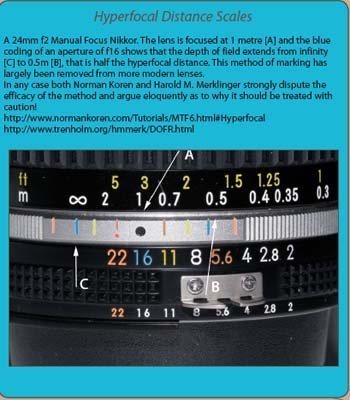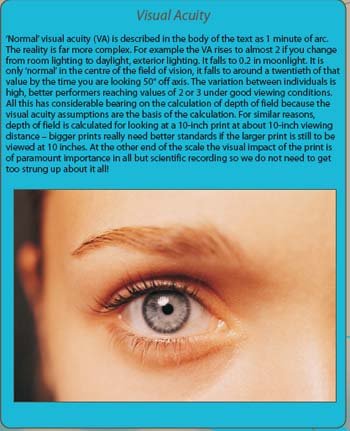articles/Lens/depthoffield-page2
Depth of Field - part 2 of 1 2 3 4 5
by Mike McNamee Published 01/08/2007

Facts about depth of field
1. It is not the same as depth of focus. They are related by the magnifi cation but depth of focus is an image-side eff ect, depth of fi eld is a subject-side eff ect. They equal each other at 1:1 magnifi cation. At normal 'landscape' distances depth of fi eld is quite large, depth of focus is very small - which is why your CCD chip has to be placed very accurately and why you have a pressure plate in the back of a fi lm camera (even a small bulge is disasterous). Conversely, at the high magnifi cations of the electron microscope, the depth of focus is so large that you can put the imaging fi lm anywhere within a few hundred yards and still get a sharp image!
2. Depth of fi eld increases as a lens is stopped down and vice versa.
3. Shorter focal length lenses give slightly more depth of fi eld for a given magnifi cation, but the eff ect is actually very small. Telephoto lenses appear to have shallow depth of fi eld because they are magnifying the image. So a 100mm lens focussed at 5m and f4 has a depth of fi eld of 501mm. A 25mm lens focussed at 1.25m (to give the same image size) and f4 has a depth of fi eld of 521mm. This is a marginal eff ect compared to say stopping down which will create a diff erence of hundreds of millimetres rather than the 20mm created by changing the focal length. At macro distances (ie 1:1) the eff ect diminishes to zero and changing the focal length has no eff ect on depth of field.

4. Depth of fi eld increases as the square of the focussed distance. This is the largest eff ect, a change from 2m to 4m creates a fourfold increase in depth of fi eld, obviously massively larger than changing the lens focal length even by four times.
5. At distances beyond 10 focal lengths (ie 'typical' photography) the depth of fi led is arranged so that the forward depth is about one third of the rearward depth. This is why you should focus a third of the way in to a group, not on the people in the front row. At macro distances this eff ect is zeroed, and actually starts to go the other way past 1:1 magnifi cation.
6. Smaller formats have more depth of fi eld at a given aperture. Thus a digital chip on a Nikon D200 is smaller and the eff ect is worth about a whole stop ie if you were shooting at f2.8 on 35mm you would need to go to f2 to have the same eff ect with a small chip DSLR.
7. Depth of fi eld reaches a maximum at the hyperfocal distance. At that point the image will be sharp from half the hyperfocal distance out to infi nity. Setting a lens at the hyperfocal distance was a technique much loved by landscape photographers of old, but the practice is now frowned upon by some theorists, who make the valid point that you lose a little distance sharpness for no great increase in foreground sharpness, especially as the DSLR is giving you more sharpness in the fi rst place.
Please Note:
There is more than one page for this Article.
You are currently on page 2
- Depth of Field page 1
- Depth of Field page 2
- Depth of Field page 3
- Depth of Field page 4
- Depth of Field page 5
1st Published 01/08/2007
last update 09/12/2022 14:53:14
More Lens Articles
There are 16 days to get ready for The Society of Photographers Convention and Trade Show at The Novotel London West, Hammersmith ...
which starts on Wednesday 14th January 2026





